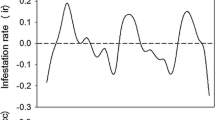Abstract
We studied the abundance of Brevipalpus spp. in citrus orchards in the Mexican states of Yucatan, Quintana Roo and Campeche. Mites were collected from 100 trees containing a mixture of citrus species where sweet orange was always the main species. Eight collections were made at each location from February 2010 to February 2011. Mites from the genus Brevipalpus were separated from other mites surveyed and their abundance and relationships with the different citrus species were quantified throughout the collection period. A subsample of 25% of the total Brevipalpus mites collected were identified to species level and the interaction of mite species and citrus species were described. Brevipalpus spp. were present on all collection dates and their relative abundance was similar on all citrus species studies. The smallest number of mites collected was during the rainy season. Brevipalpus phoenicis (Geijskes) and Brevipalpus californicus (Banks) were the only two species present and they were found in all locations except Campeche, where only B. phoenicis was present. Yucatan and Campeche are at greater risk of leprosis virus transmission than Quintana Roo because the main vector, B. phoenicis, was more abundant than B. californicus. The implications of our results for the design of more accurate sampling and control methods for Brevipalpus spp. are discussed.






Similar content being viewed by others
References
Bastianel M, Freitas-Astúa J, Kitajima EW, Machado MA (2006) The citrus leprosis pathosystem. Summa Phytopathol 32:211–220
Bastianel M, Freitas-Astúa J, Nicolini F, Segatti N, Novelli VM, Rodrigues V, Medina CL, Machado MA (2008) Response of mandarin cultivars and hybrids to citrus leprosis virus. J Plant Pathol 90:302–312
Childers CC, Kitajima EW, Welbourn WC, Rivera C, Ochoa R (2001) Brevipalpus mites on citrus and their status as vector of citrus leprosis. Manejo Integrado de Plagas (Costa Rica) 60:66–70
Childers CC, French JV, Rodrigues JCV (2003) Brevipalpus californicus, B. obovatus, B. phoenicis and B. lewisi (Acari: Tenuipalpidae): a review of their biology, feeding injury and economic importance. Exp Appl Acarol 30:5–28
De Carvalho MJL, Sato ME, Raga A, Arthur V (2008) Population dynamics of phytophagous and predaceous mites on coffee in Brazil, with emphasis on Brevipalpus phoenicis (Acari: Tenuipalpidae). Exp Appl Acarol 44:277–291
De León D (1961) The genus Brevipalpus in México. Parte II (Acarina: Tenuipalpidae). Fla Entomol 44:41–52
Hoodle MS, Robinson L, Virzi J (2000) Biological control of Oligonychus perseae (Acari: Tetranychidae) on avocado: III. Evaluating the efficacy of varying release rates and release frequency of Neoseiulus californicus (Acari: Phytoseiidae). Int J Acarol 26(3):203–214
Kitajima EW, Chagas CM, Rodrigues JCV (2003) Brevipalpus-transmitted plant virus and virus-like diseases: cytopathology and some recent cases. Exp Appl Acarol 30:135–160
Krantz GW, Walter DE (2009) A manual of acarology, 3rd edn. Texas Tech University Press, Lubbock, Texas, 807 p
Mesa NC, Ochoa R, Welbourn WC, Evans GA, De Moraes GJ (2009) A catalog of the Tenuipalpidae (Acari) of the World with a key to genera. Magnolia Press, Auckland, 185 p
Neto MP, Rebelles PR, Zacarias MS, Silva RA (2009) Influence of rainfall on mite distribution in organic and conventional coffee systems. Coffee Sci 4(1):20
Oliveira CAL (1995) Aspectos ecológicos do Brevipalpus phoenicis. In: Oliveira CAL, Donadio LC (eds) Leprose dos Citros. FUNEP, Jaboticabal, pp 37–48
Payne RW, Harding SA, Murray DA, Soutar DM, Baird DB, Welham SJ, Kane AF, Gilmour AR, Thompson R, Webster R, Tunnicliffe WG (2005) GenStat Release 8 reference manual. VSN International, Hemel Hempstead
Rodrigues JCV, Kitajima EW, Childers CC, Chagas CM (2003) Citrus leprosis virus vectored by Brevipalpus phoenicis (Acari: Tenuipalpidae) on citrus in Brazil. Exp Appl Acarol 30:161–179
SIAP (2011) http://www.siap.gob.mx/. Accessed 19 Nov 2012.
Welbourn WC, Ochoa R, Kane EC, Erbe EF (2003) Morphological observations on Brevipalpus phoenicis (Acari: Tenuipalpidae) including comparisons with B. californicus and B. obovatus. Exp Appl Acarol 30:107–133
Acknowledgments
We wish to thank Suzanne Clark for her valuable statistical advice. DFC received a scholarship from CONACYT Mexico. This research was funded by grant no. PM09-4002 from the “Comites Estatales de Sanidad Vegetal de Yucatán, Quintana Roo and Campeche” under the project “Implicaciones Epidemiológicas del CTV en el Sistema Vector-Planta: Bases Biológicas y Cuantitativas para la aplicación del Principio Erradicativo en México, financiado por los Comités Estatales de Sanidad Vegetal de Yucatán, Campeche y Quintana Roo, México”.
Author information
Authors and Affiliations
Corresponding author
Additional information
Jorge Braz Torres
Rights and permissions
About this article
Cite this article
Salinas-Vargas, D., Santillán-Galicia, M.T., Valdez-Carrasco, J. et al. Species Composition and Abundance of Brevipalpus spp. on Different Citrus Species in Mexican Orchards. Neotrop Entomol 42, 419–425 (2013). https://doi.org/10.1007/s13744-013-0140-6
Received:
Accepted:
Published:
Issue Date:
DOI: https://doi.org/10.1007/s13744-013-0140-6




